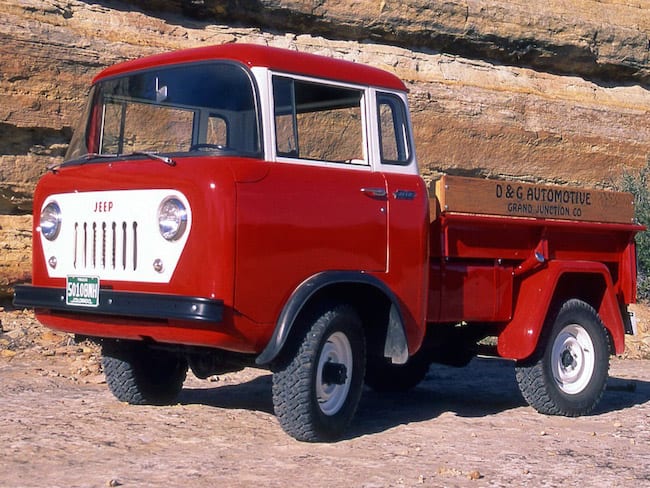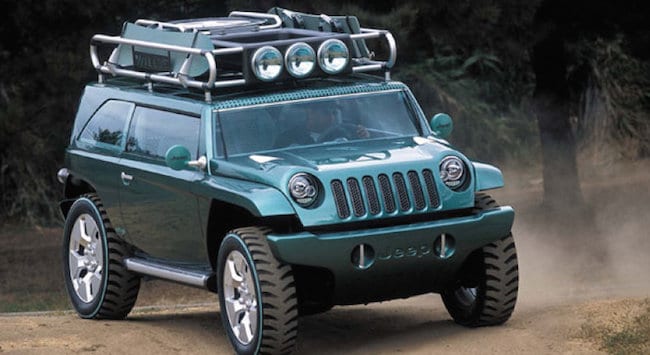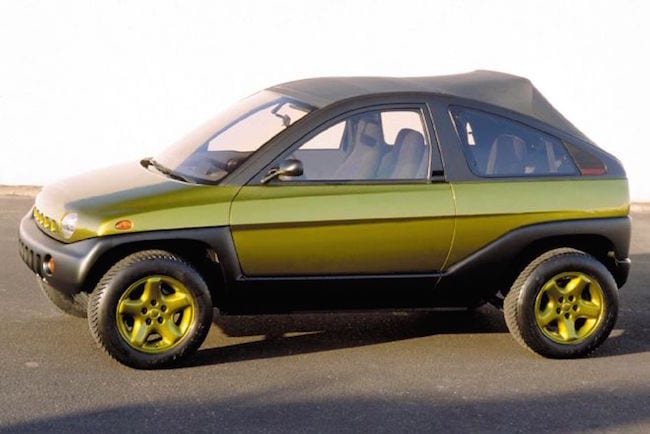There’s no denying that Jeep is one of the most popular automotive brands on the market, and many drivers are familiar the company’s variety of models, including the Wrangler, Cherokee, and Renegade. However, there are a number of vehicles made by the company that never developed that same type of popularity, leading to these Jeeps now being forgotten. Luckily, we’ve uncovered up some of these lesser-known Jeeps, compiling them for your reading enjoyment.
Unless you’re a Jeep expert, it’s likely that you’ve never heard of the models listed below.You probably won’t be able to secure any of these Jeeps via a lease, but there’s no reason why we can’t look back at the vehicles fondly…
2001 Jeep Willys2
You won’t see this vehicle for sale at a Jeep lot, so it’s understandable if you’ve never heard of this concept model. The original idea for the Willys2 was a result of Jeep’s decreasing control of the “rugged, American-brand” market, as the Hummer was quickly gaining steam. Around since the early 1990s, the Hummer (or, as it was previously known when owned by AM General, the ‘M998 High Mobility Multipurpose Wheeled Vehicle’) was officially taking its hold of the power, off-roading market.
At the same time, Jeep seemed to be prioritizing their “suburban soft-roader du jour,” as AutoBlog.com described. Looking to produce a Jeep vehicle that could compete with the Hummer, the brand decided to refer to an old friend. A team of engineers ultimately rebooted the Willy, which was the iconic Jeep vehicle that played an important role during World War II. As AutoBlog.com writes, the brand intended to create a smaller (but equally powerful) Jeep that would run for less than the $14,000 Wrangler.
The Willys2, the most innovative of the concept Jeeps, was unveiled at the Tokyo Motor Show in 2001. The Willys could easily be mixed up with a “rescue vehicle,” and the Jeep came with an assortment of features, including “salad-bowl-sized driving lights on its roof rack [and] go-anywhere 21-inch wheels.” There was also an “all-aluminum frame molded to carbon fiber body panels,” leading the blog to surmise that the vehicle could have been more expensive than anticipated.
Instead of launching the Willys2, Jeep released the Compass and Patriot in 2007, with both vehicles priced around $15,000. The two small vehicles were viewed as “imitators,” which may have hurt their public perception. The vehicles were ultimately discontinued in 2012, and the Willys idea has (unfortunately) been shelved indefinitely.
Jeep FC-150
As competing carmakers tried to compete against Jeep in the 1950s with their own unique four-wheel drive vehicles, the brand was hoping to create an exclusive vehicle that wasn’t offered elsewhere. The result? Jeep’s first new product since 1947, the FC-150 (also known as the “Forward Control” and “Flat Front”).
Advertised as a vehicle that could serve both regular consumers and the military, the Jeep was engineered by A.C. Sampieto, who based the vehicle’s design on the popular CJ-5 (particularly the vehicle’s chassis). Sitting on an 81-inch wheelbase, the Jeep originally features the Hurricane inline-four engine, which was capable of producing 75 horsepower. The engine was accompanied by a Borg Warner three-speed manual transmission, and the Jeep also included the brand’s famous “Hi-Lo” 4-wheel drive system, allowing the driver to switch between 2- and 4-wheel drive.
As the Hagley Museum and Library’s website describes, the FC-150 was renowned for its sleek look. The “Safety-View” cab made the vehicle stand out from the competition, as the distinguishable “cab-over-engine” design was unique and exclusive to Jeep. The brand was commended for their vehicle’s roomy interior (as the FC-150 was designed for “comfort”) and eye-popping amount of window glass (as the FC-150 was also designed for “visibility”). To make the cabin more accessible, the engineers also included “wide doors, concealed steps, and rubber front fenders.”
The FC-150’s versatility also set it apart from the rest, as the Jeep delivered excellent off-roading capabilities for the time. The Museum’s website notes that the Jeep was “durable and could take a lot of abuse,” making it an excellent option for those who needed a vehicle for hauling around equipment.
Despite receiving positive reviews following its initial release in 1957, the truck’s sales ended up being underwhelming. The vehicle was ultimately discontinued in 1965, and as a result of the lack of sales, you won’t see many used FC-150’s lying around today.
Still, the FC-150 is being admired today. Tom Joslin of Jalopnik.com wrote a glowing review two years ago:
“It’s a bit of a mutt, but it’s unimaginable—to us at least—that anyone would dispute the cool factor on this old Forward Control Jeep…The design was the unique brainchild of Brook Stevens, but underneath these utilitarian beasts were mostly CJ-5. You need look no further than Jeep’s “torture us with a model they won’t build” Mighty FC concept to see that the same concept and basic design is still just as cool, if not cooler now as it was when new.”
1993 Jeep Echo
Long before we were admiring the 2015 Jeep Renegade, the company had wanted to engineer a “baby Jeep” (as described by Evan McCausland of AutoMobileMag.com). This led to them unveiling a concept for their 1993 Jeep Echo at the Detroit Auto Show. Marketed towards “the environmentally-aware generation,” the Echo’s body structure was composed of aluminum, wrapped in plastic panels. This made the vehicle 100-percent recyclable.
Coming in a 143-inches long (or, for those counting at home, nearly two feet shorter than the 2015 Renegade), the Echo included a two-stroke, all-aluminum, 1.5-liter three-cylinder motor, capable of delivering 85 horsepower and 120 ft-lbs of torque. Those might be some low power specs, but even then, the engine still weighed less than the standard 2.0-liter four-cylinder Jeep engines. Furthermore, the engine included both “direct fuel injection” as well as “supercharger” technology.
The brand would travel to various auto shows to show off their idea, and the vehicle was generally well received by pundits.
“At virtually the opposite end of the spectrum [of the Dodge Ram pickup], spiritually and conceptually, was the tiny, environmentally correct Jeep Ecco,” Automobile Mag had said in 1993. “The Ecco makes use of the vertical-slot Jeep grille, one of the best-known and best-loved car “faces” in the world. The Ecco features recyclable materials and a lean-burn 1.5-liter, 85-bhp three-cylinder two-stroke engine. The wheelbase is 100.3 inches with a minuscule overall length of 143.0 inches – more than a foot shorter than a Honda Civic del Sol.”
Despite the generally warm reception, the brand didn’t end up making their “baby Jeep” for nearly 15 years. Finally, the Jeep Compass and Jeep Patriot were released in 2006, somewhat satisfying the market’s desire for a small version of the iconic Jeep. The two-stroke engine saw its demise around the same time. Although it was rumored to be included in the Dodge and Plymouth Neon, it was eventually trashed for financial reasons.
While the Echo could never be appreciated by Jeep lovers, that doesn’t mean the vehicle is gone forever. It lives on within Chrysler’s “historical vehicle collection,” meaning it shouldn’t even be forgotten.
If you happen to come across one of these Jeeps for sale, you’re in fact the luckiest person in the world (seriously, you should buy a lottery ticket or, like, avoid lightning). However, you’ll still be able to see some of these concepts and features included in the design of today’s SUV models. These Jeeps may not be available, but they’ve clearly made an impact on the company.






